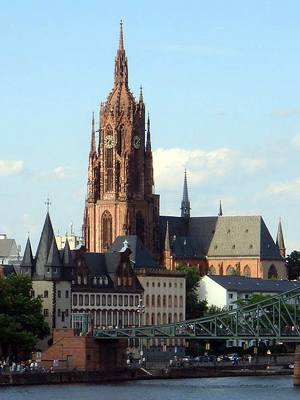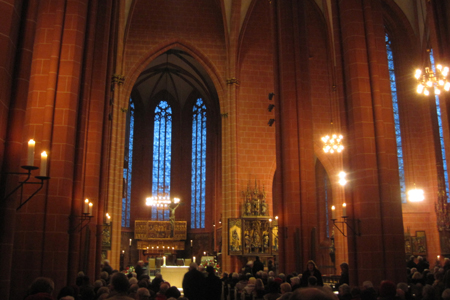| |
 |
 |
 |
| Comment on this report, or find other reports. |
 |
| Our Mystery Worshippers are volunteers who warm church pews for us around the world. If you'd like to become a Mystery Worshipper, start here. |
 |
| Find out how to reproduce this report in your church magazine or website. |
|
|
| 2655: Imperial
Cathedral St Bartholomew, Frankfurt am Main, Germany |
 |

Photo:
© rupp.de and used under license
|
 |
Mystery
Worshipper: Portola.
The church:
Kaiserdom
Sankt Bartholomäus, Frankfurt am Main, Germany.
Denomination:
Roman-Catholic,
Diocese
of Limburg.
The building:
A Gothic church in the center of Frankfurt, constructed in the
14th and 15th centuries on the foundation of an earlier church.
"Cathedral" is an honorary title, as it was never
the seat of a bishop. It is the largest church in the diocese,
featuring a spire that is 95 meters high. From 1356 onwards,
emperors of the Holy Roman Empire were elected in this church
as kings in Germany, and from 1562 to 1792, emperors-elect were
crowned here. In 1867, St Bartholomew's was destroyed by a fire
and rebuilt in its present style. During World War II the church
suffered severe damage due to Allied bombing; the interior was
burned out completely. It was reconstructed in the 1950s.
The church:
Every Catholic service in the Diocese of Limburg is somewhat
under a shadow as the diocese tries to recover from a horrible
scandal that dominated news reports in Germany for several weeks.
In 2013 the Bishop of Limburg, Franz-Peter Tebartz-van Elst,
was accused of lying under oath (for which he has been penalized
€20,000) in connection with first-class travel expenses;
he is also under fire because of the extravagant costs of renovations
to the bishop's residence. The bishop’s style of leadership
has been described as rigidly authoritarian, and he was unpopular
long before he became controversial. On 13 October he was temporarily
suspended by Pope Francis as Bishop of Limburg.
The neighbourhood:
Frankfurt is at the center of the Rhine-Main Metropolitan Region,
which has a population of 5,600,000, and is Germany’s second
largest metropolitan area. Since the enlargement of the European
Union in 2013, the geographic center of the EU is 40 km (25
mi) east of Frankfurt. Directly adjacent to the cathedral is
an archaeological garden displaying excavations of a Roman settlement
and a Carolingian royal palatinate, illustrating that the cathedral
was built at the oldest part of Frankfurt. In 794, Charlemagne
built a royal court at Frankfurt and convened a church council
here. The cathedral stands near all of these ancient sites.
In the area to the west of the cathedral, the Old City area
is being completely rebuilt; several medieval houses that were
destroyed during World War II bombing will be reconstructed.
This rebuilding project will partially block the view of the
cathedral from the direction of the main market place, which
has aroused protest.
The cast:
His Eminence Karl Cardinal Lehmann, Bishop of Mainz, was principal
celebrant and preacher. Co-celebrating were the Rt Revd Dr Thomas
Löhr, Auxiliary Bishop of Limburg, the Revd Dr Johannes
zu Eltz, Stadtdekan (city dean), and several other priests whose
names were not given. Music was provided by the Frankfurter
Cathedral Choir; the Vocalensemble Liebfrauen (Vocal Ensemble
of Our Lady, the largest choral group at the Frankfurt Church
of Our Lady); the Cappuccinis Choir of St Bernhard; the Choralschola
of St Batholomäus; and the Frankfurter Cathedral Brass Choir
– all under the direction of Herr Stefan Poppe. Also participating
were the district cantor, Herr Peter Reulein; and the cantor,
Frau Bjanka Ehry. The organ was played by Herr Andreas Boltz.
The date & time:
Saturday, 25 January 2014, 6.00pm.
What was the name of the service?
Karlsamt (literally "Office of Karl"): a
mass honoring Charlemagne, who died on 28 January 814. This
mass is celebrated annually in Aachen and Frankfurt on or close
to the date of his death.
How full was the building?
It was packed, with people standing in the aisles. The size of the congregation was estimated to be 1000.
Did anyone welcome you personally?
No.
Was your pew comfortable?
I entered the church one hour before the service was to begin
and all of the pews were filled to capacity. I found a seat
on a wooden block, which I shared with a person standing on
it behind me, in a side chapel at a back corner of the church.
I was able to look into the nave through metal bars, which conveyed
the feeling of being in a prison cell. On the other side of
the prison bars was a wall of people, standing in the adjacent
aisle, blocking my view. At this location the acoustics were
not good, so that I was not able to understand every word.
How would you describe
the pre-service atmosphere?
The congregation were quiet. Conversations were subdued. On
the other hand, the choir and the brass band were rehearsing,
which made the atmosphere festive. One-half hour before the
service, an unnamed speaker gave some historic background information
about the Karlsamt.
What were the exact opening words of the
service?
Stadtdekan Johannes zu Eltz greeted the congregation by saying:
"The city church rejoices that you celebrate with us."
The first words of the liturgical service, spoken by Cardinal
Lehmann: "In nomine Patris, et Filii, et Spirirus Sancti."
What books did the congregation use during the
service?
A pamphlet contained the liturgy and the words of the hymns
with musical notes. However, some parts of the liturgy were
expected to be spoken and sung from memory.
What musical instruments were played?
Organ, brass choir, timpani.
Did anything distract you?
One distraction was that many people left before the end of
the service, which lasted almost two hours. After the sermon
there seemed to be a steady trickle of visitors heading toward
the exit. Another distraction for me personally was that there
was so much historical perspective to think about. Before the
service, when the congregation were given historical background
information, it was mentioned that the Emperor Augustus died
in the year 14. I could not help thinking again and again during
the service about an irony of history. Augustus was celebrated
as the Son of God and Saviour of the world, titles that were
bestowed upon another person born during his reign and acknowledged
2000 years later by over two billion people worldwide.

Was the worship stiff-upper-lip, happy clappy, or
what?
This service was as high-church as it gets. The liturgy of the
Karlsamt, completely in Latin, originated in the 15th
century, incorporating a 12th century prayer, the Karlssequenz
("Charles sequence"), and a prayer of praise and intercession
called the Kaiserlaudes, which was sung beautifully
by a female cantor and the choirs. The organ, the brass choir
and the timpani provided a sublime accompaniment to the hymns.
The procession and recession through the center aisle featured
many priests and nuns, as well as representatives from three
Catholic orders, dressed in splendor: the German, the Maltese
and the Order of the Holy Sepulchre. The service was carried
out efficiently.
Exactly how long was the sermon?
18 minutes.
On a scale of 1-10, how good was the preacher?
7 – The Cardinal Bishop spoke rather quickly, so that his
sermon was sometimes difficult to follow due to the poor acoustics.
His sober style and academic language were appropriate to the
content of his message.
In a nutshell, what was
the sermon about?
The sermon was a lecture about Charlemagne, referred to in Germany
as Karl the Great. Cardinal Lehmann emphasized how hard it is
to understand and to judge a person who lived 1200 years ago,
especially on the basis of contemporary standards. The available
documents, which are not objective, do not allow us really to
know the true character of Karl. His empire was the basis for
today’s Europe. He founded monasteries and libraries that preserved
and created the cultural and literary foundation of Europe.
Although Karl could not read or write, he brought about a unified
script within his realm. He initiated reforms, he helped the
church to develop, but he used ruthless violence to achieve
his goals, including mass executions and forced baptisms. If
I heard correctly, Karl and Great was referred to as a cultured
barbarian. Karl the Great, as all of us today, are in need of
forgiveness.
Which part of the service
was like being in heaven?
Several elements of this service were heavenly. As one enters
the church, especially in the evening, the red-sandstone walls
and columns convey a warm and inviting atmosphere. Before and
after the service the massive Gloriosa was rung (29,290 pounds,
2.66 meters high). This bell produces a sound that penetrates
to the bone-marrow, as though the Last Judgement and the Resurrection
of the Dead were being announced. The cantor (a woman) who led
the singing of the liturgical prayers had a sweet, rich voice,
which was a joy to listen to. And one final heavenly moment:
until the passing of the peace I felt cut off from the congregation
due to my isolated location in a side chapel. But when I exchanged
the peace of the Lord through my "prison bars", I
immediately felt as though I was part of the congregation.
And which part was like being in... er... the other place?
One of the prayers of this service must have been excruciatingly
ironic for those who have suffered from the present crisis in
the diocese. The congregation prayed "for our bishop Franz-Peter,
the beloved father of faith: may he receive the fullness of
life." The momentarily exiled bishop is anything but a
"beloved father of faith", and striving for a luxurious
"fullness of life" is exactly what he has been accused
of.
What happened when you hung around after the service looking lost?
When 1000 people are leaving a church at the same time, everyone looks lost.
How would you describe the after-service
coffee?
No coffee.
How would you feel about making this church your regular (where 10 = ecstatic, 0 = terminal)?
5 – Since I am not a Roman Catholic I could never feel
at home here. But I do appreciate the discipline and efficiency
of a Catholic worship service.
Did the service make you feel glad to be a
Christian?
Yes, indeed. This service gave one a feeling for the long history and continuity of Christianity. The ancient texts of the liturgy were an expression of my faith.
What one thing will you remember about all this in seven days' time?
The warmest moment of this service came at the end. In his closing
remarks, Cardinal Lehmann reached out to the congregation, thanking
them for their celebration of this service and thanking them
for enduring the present crisis in the diocese. He greeted the
exiled bishop (who was, of course, not present) and expressed
the hope that a solution would soon be found that will be beneficial
to both the bishop and to the diocese. The congregation applauded
his remarks. |
|
|
 |
 |
 |
| We rely on voluntary donations to stay online. If you're a regular visitor to Ship of Fools, please consider supporting us. |
 |
 |
 |
| The Mystery Pilgrim |
 |
| One of our most seasoned reporters makes the Camino pilgrimage to Santiago de Compostela in Spain. Read here. |
 |
 |
 |
| London churches |
 |
| Read reports from 70 London churches, visited by a small army of Mystery Worshippers on one single Sunday. Read here. |
| |
|
|
|
|


